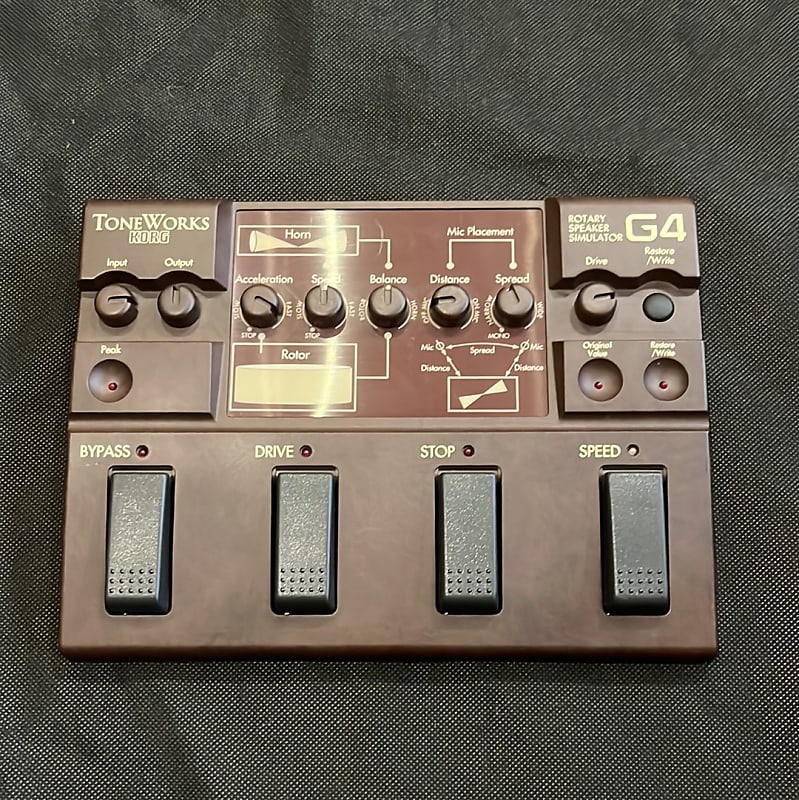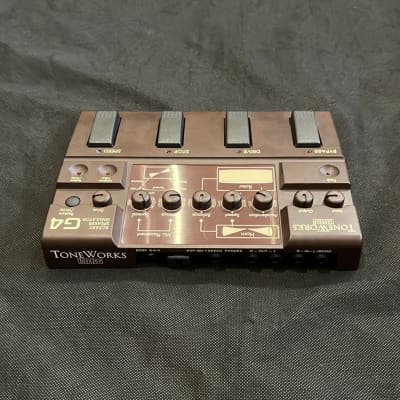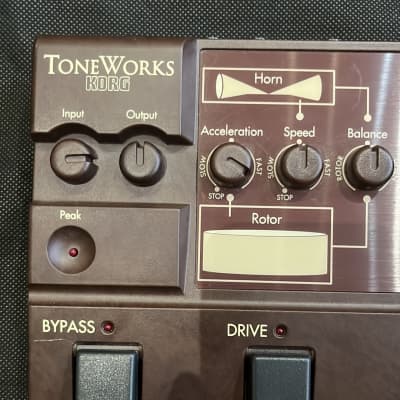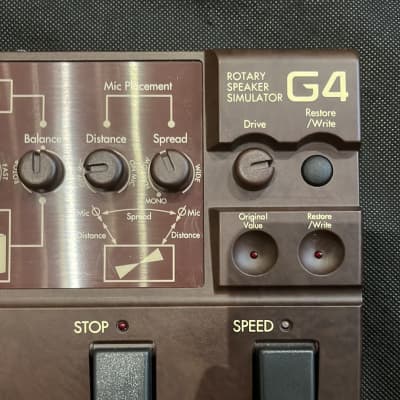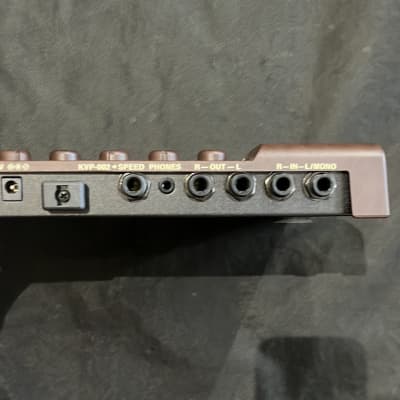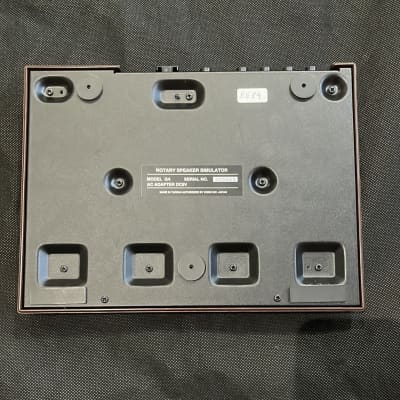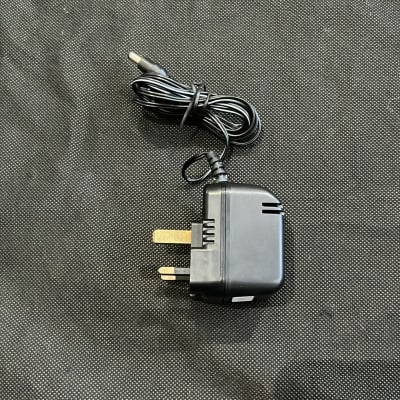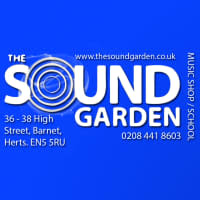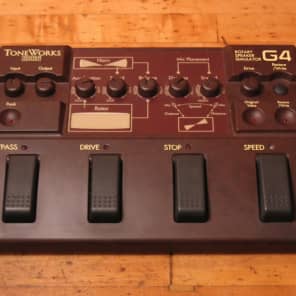For help and advice please call 020 8441 8603
All items can be seen and collected from our store :
Sound Garden, 36-38 High Street, Barnet, EN5 5RU
5 Minutes from junction 23 of the M25
Opening hours 10-6 PM Monday-Saturday
Korg Tone works G4 Rotary speaker simulator, Used
Great Condition.
Description :
The G4 provides all the facilities of a valve‑amplified Leslie: overdrive, distortion, tonal modification, independent rotor speeds, and braking. These are controlled by four pedals: Bypass, Drive, Stop, and Fast/Slow; plus eight knobs: input volume, output volume, rotor speed/acceleration, horn speed/acceleration, rotor/horn balance, speaker‑to‑microphone distance, bass and treble microphone separation, and amount of overdrive. The first two knobs are trivial — set the input level so that the input level LED flashes only at peak playing levels, and set the output level to get the best from your amplifier or mixer. It's the other six which are of real interest...
The Leslie Effects
There are three factors affecting the bass sound of a Leslie — the rotor's slow (chorus) speed, its high (vibrato) speed, and the rate of acceleration and deceleration between the two. Korg have applied some simple physics to link the three in an algorithm they call 'IPE' — the Integrated Parameter Editing system — claiming that, because the factors are associative, a single algorithm can set them to optimum combinations each time you adjust the speed. Consequently, if you set the chorus speed to a 'high' value then the tremolo speed is also 'high', and the acceleration and deceleration are high (ie. it doesn't take long to change speed). Conversely, low rotation speeds result in less rapid acceleration and deceleration. So, although the knob is labelled 'speed', the IPE system isn't setting the speed at all — it's increasing and decreasing the power applied to the rotor which makes it rotate in the first place. In use this is fine, and apart from one or two occasions when I might have preferred a high 'slow' rotation speed with more rapid acceleration, I found Korg's combinations quite acceptable. The control is continuously variable between its extreme settings, the lowest of which causes the rotor to be 'stationary'.
From Dave Brubeck to Booker T, Keith Emerson to Jon Lord, the G4 grunts and growls its way through all manner of playing styles with a class totally belying its humble price tag.
The treble horn control is also labelled 'speed', but it too affects acceleration and deceleration. However, unlike the rotor control, when the speed is high the acceleration is low, and when the speed is low the acceleration is high. In this case, the IPE isn't setting the speed or the power — it's increasing and decreasing the mass of the horn assembly. Korg's combinations are again quite acceptable. There is an LED associated with the horn speed, and this flashes in time with the horn rotation, also letting you know whether the rotation is fast (red) or slow (green). And, as a bonus, if the horn stops rotating, the LED shows the speed of the bass rotor. Neat.
A third knob adjusts the relative volumes of the treble horn and the bass rotor, and this demonstrates how well Korg's developers have analysed the Leslie sound. A real Leslie speaker has a 'hole' in its frequency response, such that not only is there no overlap in the frequencies output by the horn and the rotor, there is a narrow band almost totally missing from the speaker's output. Without this hole, Leslie simulations do not sound convincing. Rotating the Balance control from one extreme to the other demonstrates that the G4 correctly imitates this: some middle frequencies are missing, and the sounds output from the horn and the rotor are quite different, lying, as they should, on either side of this hole. The treble horn alone gives a nasty scratching sound ,and the bass rotor alone is just a woolly muffle. Perfect!
Distance And Separation
Now you may think that emulating the Leslie speaker is the end of the story, but it's not. Unless you're standing on‑stage, you'll never hear a Leslie except through a PA or hi‑fi system. There are techniques for miking up and recording Leslies that can contribute enormously to the sound, and any engineer worth the title knows how to get the best result for the type of music being played. Fortunately, for a given set of microphones, there are only two factors that influence the sound: the distances of the mics from the cabinet itself, and the angle between them.
Only two microphones are used to capture the output from a Leslie: one mounted at the level of the treble horn, the other at the level of the bass rotor. If these microphones are very close to the speaker cabinet there is a significant difference between the sound picked up when the rotor (or horn) is facing a microphone, and that picked up when the rotor (or horn) is facing away. Consequently, close positioning produces the deep, swirling effect beloved by so many organists. Moving the microphones progressively further from the cabinet diminishes the difference between the extremes of the sound, especially when room ambience becomes a significant part of the signal. The G4 emulates a wide range of distances from, at one extreme, very close positioning, through to the less dramatic effect associated with greater microphone distance.
However, it would be unusual to place the two microphones directly above and below each other — the result would be very 'monophonic'. Separating them by an angle between 0º and 90º adds a dramatic stereophonic effect which enhances the modulations created by the Leslie itself. The G4 allows you to control the separation angle and set it anywhere between these limits, yet again showing just how well Korg's boffins have done.
The Overdrive
Despite all the above, there's yet another essential element in the classic organ sound: grit, bite, guts. Distortion occurs throughout the sound generation path of an old organ — dirty tonewheels, ageing pre‑amps, anguished Leslies and, of course, fistfuls of valves adding their characteristic buzz — so no Leslie simulator can be complete without an on‑board overdrive.
Digital overdrives have been improving rapidly over the last two or three years. Early digital effects units had a nasty, fizzy, annoying character that guitarists would spend hundreds of pounds avoiding. Thankfully, these have been replaced by much higher quality imitations such as the Roland GS6 and, more recently, Korg's own A1, which features a very passable valve overdrive effect. Korg have applied their experience with the A‑series to the G4 which, at low drive settings, adds warmth where most outboard units merely add rasp, and, at high settings, screams. From Dave Brubeck to Booker T, Keith Emerson to Jon Lord, the G4 grunts and growls its way through all manner of playing styles with a class totally belying its humble price tag.
Other Facilities
Yet this still isn't the end of the goodies tucked away inside the diminutive G4. For example, Korg have also analysed the tonal characteristics of stationary Leslie speakers and hidden a speaker simulator in the software. Regretfully this doesn't have its own control, but is instead toggled using a combination of the 'speed' and 'bypass' switches. This isn't too much of a problem — after all, if you're playing direct to a desk you'll want the simulator on all the time, and if you're playing 'live', directing the output of the G4 to an amplifier and cabinet, you'll almost always want the simulator off. The tonal change imparted by the simulator is refreshingly subtle. There is some rounding off of high frequencies (quite right too) and a number of cabinet‑like resonances are added in the mid‑range. More brownie points.
The G4 instantly turns any vaguely organ‑like patch into a gritty, dusty old C3.
There is also a 'bypass' function, a 'full‑stop' pedal, and a 'speed' input which allows you to connect either a simple latch‑type switch or a standard volume control pedal to the back of the G4. A latch enables you to switch between fast and slow rotation speeds even if you can't reach the G4 itself, but the real fun begins with the volume pedal, which dynamically controls the rotation speed, allowing you to determine not just fast and slow speeds, but any shade between. There's a memory too, so if you have a precise setup you wish to retain (maybe synchronising the rotation speeds with a sequence, or some such effect) you can store this.
Larger photos available on request
Sensible offers will be considered
This item can be tried at our High Street store at 36-38 High Street, High Barnet EN5 5RU
Credit card hotline :
020 8441 8603
Please read my feedback and buy with confidence.
Free postage is UK mainland only. Highlands and Islands may be more, please contact us for details. Can be collected.
